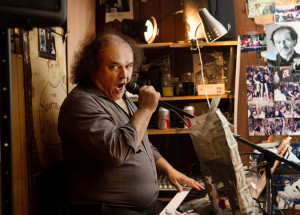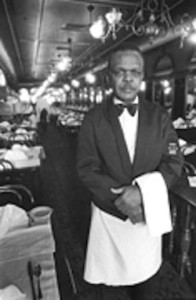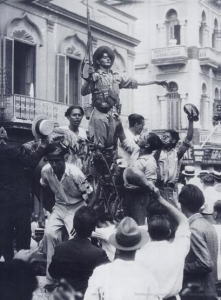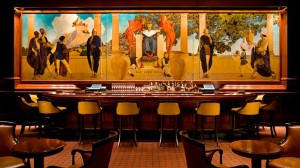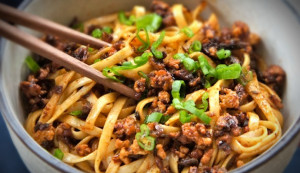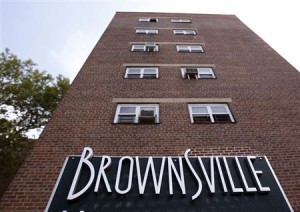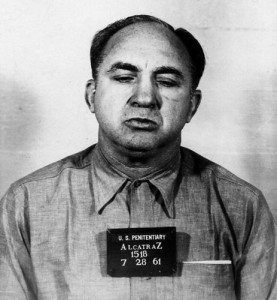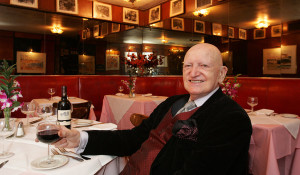During HG’s younger years in New York, there were many Hungarian (and Czech) restaurants on Lexington, Third and Second Avenues in the East 80’s and 90’s. The Czech restaurants specialized in tasty duck dishes. HG characterized the Hungarian eateries as “goulash by candlelight joints.” One of their common features was violin music provided by a “Gypsy” musician. The “Gypsy” would swoop down on individual tables and with many swooping gestures and soulful glances provide the diner with renditions of schmaltzy middle European cafe favorites. The object was to enhance the romantic mood of the diners. Somehow it worked (or maybe it was the copious amount of Egri Bikaver “Bull’s Blood” Hungarian red wine HG consumed). The “Gypsy” would continue to saw away until he was tipped. HG far preferred the “oompah, oompah” music provided by the band at Luchow’s, the glorious German restaurant on 14th Street. There were few jollier places in New York than Luchow’s during Christmas season when the venerable walls were adorned with holly and sparkling lights and the band focused on happy carols. Another pleasant winter music dining venue was the Edwardian Room of the Plaza Hotel. A cocktail pianist tinkled away in the background as diners ate in the handsome room gazing out at snow falling on Central Park. HG recalls a little steak house (name, alas, forgotten) where the owner, accompanied by a portable keyboard, sang show tunes to individual tables. His whiskey roughened voice was perfect for “Fugue for Tinhorns” from “Guys and Dolls.” And, then there’s Sammy’s Romanian on the Lower East Side. For many decades Sammy’s has featured music from singers, violinists and pianists singing old Yiddish music hall chestnuts and some popular melodies interspersed with low end, politically incorrect humor. The latest incarnation is Dani Luv, an Israeli born pianist with a killer Louis Armstrong impression. His audience, liberally stoked with vodka, garlic and chicken fat, is raucously appreciative.
Music For Dining
July 15th, 2015 § 2 comments § permalink
The African American Waiters Of Old New York
July 13th, 2015 § 2 comments § permalink
In the New York of yesteryear, being a waiter was a profession not just the way-station for actors, models, etc. that it has become. It was a job with which you could raise a family, buy a modest house and lead a life of some dignity. These lifers of the restaurant industry teemed in both ethnic enclaves — Swarthy, smiling Sicilians in Little Italy, surly Jews (“Is the chopped liver good?” “Too good for you”) in the Lower East Side — and some of the older bastions of “Yankee” cooking that were almost exclusively staffed by very dignified, efficient, slightly austere African-American waiters (SJ presumes that this development must have occurred during the “Great Migration” as millions of African American families moved North bringing with them the vastly influential “Low Country” culinary and dining traditions). The late, lamented Gage & Tollner’s in downtown Brooklyn had veteran waiters who had served the old, aristocratic Brooklyn Heights families for decades. The waiters had gold stripes on the sleeves of their jackets denoting their years of service. Lundy’s, on Brooklyn’s Sheepshead Bay, also had dignified African-Americans providing service. Hamburg Heaven, adjacent to Saks Fifth Avenuue, was a favorite of fashionable women. All of the personnel were African-American and casually pleasant. When HG lived in Montclair, NJ., HG often dined at the Wedgewood Cafeteria (closed for many years). It was, even in the 1970s an old-fashioned and gracious establishment much favored by blue-haired ladies and other mature folk. There were many dishes like chicken a la king which did not make demands on people masticating with dentures. The Wedgewood had a unique feature which set it apart from the rough and ready cafeterias like the Belmont, Dubrow’s and others HG frequented in Manhattan: After you ordered your food at the counter, your tray was delivered to your table by a member of the elderly and endearing African American staff who seemed to personally know and care for their aged customers. This made a Wedgewood Cafeteria meal quite an elegant experience.
Sammy Schulman
July 12th, 2015 § 0 comments § permalink
HG’s invaluable correspondent, Charles Curran, noted that his favorite sandwich is Braunschweiger on Jewish rye with French mustard and sweet onion. HG thought of this yesterday as HG munched on a liverwurst-ciabatta-Maille mustard-Vidalia onion open sandwich. HG was introduced to this hearty treat by noted news photographer Sammy Schulman. (This was 1954 when HG was an editor/ TV writer at International News Photos). Sammy had covered scores of important news events and was familiar to many world leaders. He was FDR’s favorite photographer. When Sammy was absent from a Roosevelt news conference, FDR queried: “Where’s Sammy?” (“Where’s Sammy?” is the title of a book about Schulman by journalist Bob Considine). Sammy was a chubby little fellow. But, tough. During his stay in France he had learned the French art of kickboxing (Savate) and used it to good effect when being pushed around by bigger photographers in pursuit of a picture. Sammy gave stern orders when he was composing a photo. Andy Rooney (of TV fame) was a journalist in London during World War Two, and reports this incident: Sammy had been directed to get a photo of Queen Elizabeth opening an American Red Cross center. She was leaving when Sammy grabbed her arm gently: “Hold it right there for a minute, will you please, Queen.” Rooney reported: “This wasn’t a question. Sammy wasn’t asking her. He was telling her.” Her Majesty obeyed. Sammy got his picture. There is one Schulman photo that is iconic, reproduced thousands of times and part of MOMA’s permanent collection. It was taken in Havana during a 1933 Cuban uprising. A young soldier had just shot and killed a hated security officer. An adoring crowd put the soldier on a pedestal and the soldier posed, happily lifting his rife. For decades, this photo symbolized revolution.
Art In Restaurants
July 5th, 2015 § 0 comments § permalink
One of the nice things about living in Santa Fe is the art. Of course, there are scores of galleries (some kitsch but mostly first rate) and a surprising number of museums for a city its size. But, there’s quality art almost everywhere–in banks, restaurants, public buildings, shops, offices, etc. HG’s doctor, for example, has a splendid Dali hanging in her consulting room. One of HG’s favorite spaces is the very good Compound Restaurant on Canyon Road. In an old adobe building, the restaurant was designed by the late Alexander Girard and the sun washed interiors are decorated with a few striking pieces of primitive art. (Girard contributed 106,000 pieces to Santa Fe’s Museum Of International Folk Art). New York has some splendid restaurant art, much enjoyed by HG during HG’s long residence in HG’s once beloved city (now a theme park for the international oligarchy). The now threatened Four Seasons Restaurant in Mies van der Rohe’s Seagram Building has a Lippold sculpture, Bertoia curtains, and a revolving display of paintings by modern masters (The Picasso ballet curtain, alas, has been removed). There is no better place for cocktails than The King Cole Bar in the St. Regis Hotel. (HG/BSK have a special fondness for the hotel since, just abut 52 years ago, the duo had an afternoon reception in the elegant Library room following a morning wedding). King Cole, that merry old soul, is celebrated at the bar with a majestic Maxfield Parrish mural. Gaze at it in wonder as you sip a martini during your next New York visit. But, bring an active credit card. Drinks and snacks are very expensive (but worth it). Another wondrous interior is the Cafe des Artistes (now called Leopard at des Artistes).on W.67th Street. The walls are adorned with frolicking, bare-breasted forest nymphs painted by Howard Chandler Christy. Enchanting. (Some 5l years ago, HG/BSK lived next door to the des Artistes at 27 W. 67th and sometimes popped into the cafe for a drink). The long closed Jams Restaurant introduced Alice Waters-influenced California cuisine to New York. The owners, Melvin Masters and Jonathan Waxman, hung striking modern art on the walls. There are two restaurants with caricatures on the walls–Sardi’s and Palm. Sardi’s features theatrical figures and Palm has Depression era stuff by cartoonists from nearby newspapers (The artists got a free meal). Palm has restaurants throughout the country and has caricatures of local personalities (and good customers) on its walls. When HG resided in Denver, HG often lunched at the Denver Palm outpost at a booth beneath a flattering caricature of HG. Fame.
52 Years of Wonderful Times
July 3rd, 2015 § 4 comments § permalink
July 2, 1963. Fifty two years ago in New York. HG/BSK wed in the Foley Square chambers of Judge George Postel. Wedding brunch at Longchamps on lower Broadway. Sweltering heat wave, but BSK glowed with chic loveliness at HG/BSK’s afternoon reception in the St. Regis Hotel’s elegant Library Room (Bucky Pizzarelli supplied sublime guitar melodies). Dinner that night (with BSK’s family) at Fleur de Lys, little French restaurant near HG/BSK’s 27 W. 67th Street apartment. HG indulged in a platter of heavily garlicked escargots. This caused BSK discomfort as HG secreted pungent waves of garlic in the non-air conditioned apartment. BSK pondered (and not for the last time) whether the marriage was an error. HG/BSK and the marriage survived the evening. Today, on blissful Prince Edward Island, the duo raised breakfast coffee cups and agreed that their long journey together has been very rewarding. Tonight’s anniversary dinner will be a platter of shucked oysters (with BSK’s invigorating shallot vinaigrette), linguine con vongole (loads of little neck clams). Lessons have been learned. Garlic will be handled judiciously. Pecan butter tarts with ice cream for dessert. HG’s wish: Many more years with the love of HG’s life, the lovely, generous, talented, compassionate, sensitive BSK, the best wife, lover, mother, grandmother and companion. And, happily, BSK can cook.
Chinese Sesame Noodles
July 1st, 2015 § 0 comments § permalink
HG first tasted an appetizer of Chinese sesame noodles at Shun Lee, a good Chinese restaurant near New York’s Lincoln Center. A pleasantly suave dish, it made a nice accompaniment to pork dumplings and spring rolls. HG would make the noodles more lively by judicious applications of hot chili oil. These were timid noodles compared to the Tan Tan noodles served at Chongquing Szechuan Restaurant on Vancouver, B.C.’s gritty Commercial Drive. When HG/BSK were part time residents of Vancouver, HG always had the noodles as part of an exemplary dim sum brunch. The noodles were bowls of fire, the ingredients swimming in a sea of chile enriched sesame oil, properly named “fire oil.” HG’s palate was cooled by numerous cups of tea. HG encountered similar fiery noodles at Talin, an international foods supermarket in Santa Fe. The market has a ramen bar. A Monday pop up offers dumplings, soup, pork belly wraps and Dan Dan noodles. (On Fridays and Saturdays Vietnamese spring rolls are served at the ramen bar.) HG, a dedicated consumer of Asiatic (as well as Italian) noodles, often varies his consumption of Saigon Cafe’s pho with Talin’s Dan Dan variety. The other week, HG got a surprise. Expecting a mouthful of flames, HG ordered Talin’s Dan Dan noodles. Though described as Dan Dan noodles, the dish was really noodles in a variant of Mo Po Tofu sauce. The sauce contained ground pork, tiny cubes of tofu and shavings of scallion. Topped with slices of cucumber. No complaints from HG.Managed to knock off a generous bowl. Of the many variants of Dan Dan noodles, HG prefers the version HG/BSK learned years ago at the Upper West Side cooking classes conducted by Karen Lee. There’s a full account of the dish on a previous HG post: KAREN LEE COOKING CLASSES.
The Four Seasons
June 3rd, 2015 § 2 comments § permalink
If there is one restaurant that symbolizes the splendor, the taste, the cosmopolitan flavor of New York it is The Four Seasons. It is located in an iconic building, the bronze beauty — the Seagram Building situated on a lovely Park Avenue plaza. The building is a masterwork by the great architect Ludwig Mies van der Rohe (HG was honored to be Mies’s publicist while Mies was developing projects in Newark and Baltimore). Designed by Mies in collaboration with Philip Johnson, the restaurant opened in 1959 and is a supreme example of the best in mid-century design. HG/BSK dined there often (in the shimmering Pool Room) and HG would meet with public relations clients in the Grill Room, home of “power lunches.” Marvelous art and artifacts (tableware designed by L. Garth Huxtable is in the permanent collection of the Museum of Modern Art). Rotating art featured work by Jean Miro and other greats. Sculpture by Richard Lippold and metal curtains by Frank Bertoia. Jackson Pollock’s “Blue Poles” had a temporary home there (rented from collector/dealer Ben Heller). A striking feature, hung between the Pool Room and the Grill Room, was Pablo Picasso’s curtain designed for the Ballet Russes ballet “Le Tricorne.” Following a dispute with the Seagram Building’s owner, Aby Rosen, the curtain has been removed and now hangs in the New York Historical Society Building. Disputes with Rosen have continued and it now appears the restaurant may have to move from the building to another location. This is a tragedy. It means the destruction of a seamless work of art, one that defines New York and the era in which the restaurant was created. Yes, when HG mourns the end of Lindy’s, Luchow’s, Tip Toe Inn and many lesser eateries, HG can be accused of Old Fogeyism. The Four Seasons is another matter. Moving from the Seagram Building means the desecration of a work of timeless art.
Brunzville AKA Brownsville
June 1st, 2015 § 2 comments § permalink
HG grew up in a Yiddish-speaking home. There was English, heavily accented English. It wasn’t until HG began elementary school that he learned the proper pronunciation of many words. HG accompanied Mom on bargain seeking forays to busy Bethkit Avenue in the East Bronx. Much later, HG discovered the street was pronounced BATH GATE Avenue (As in the Doctorow book, Billy Bathgate, the basis of the Dustin Hoffman-Bruce Willis film). Similarly, HG thought the far off section of Brooklyn where Mom’s relatives lived was Brunzville. Yes, Brownsville. Little HG enjoyed visits to Brownsville. HG’s cousins showed HG all the local sights: The candy store that was the hangout of Abe “Kid Twist” Reles, “Pittsburgh Phil” Strauss, “Tick Tock” Tannenbaum and other members of the lethal “Murder, Inc.” crew (These bad guys all wore natty wide brimmed fedoras, HG observed); the gym where Al “Bummy” Davis, “Schoolboy” Friedkin, Morrie Reif and all the other Jewish fighters trained; Pitkin Avenue with its movie theaters and Wyona Street with pushcarts and delicatessens. That Jewish enclave, settled by immigrants fleeing the Lower East Side, produced more than killers and prize fighters: Many show business stars (Danny Kaye and Shelley Winters among others); literary lights (Alfred Kazin); doctors, lawyers, Nobel Prize winners. For many years, Brownsville has been an African-American ghetto with few redeeming features. Mike Tyson is probably its most prominent alumnus. Mayor DeBlasio has promised new housing, policing, etc. for Brownsville. HG is hopeful this will mean a better life and future for Brownsville’s citizens. They deserve it.
Maxie And Mickey
May 24th, 2015 § 2 comments § permalink
On October 21, 1929 (just days before the stock market crash which ushered in The Great Depression) there was a sell out crowd at New York’s Madison Square Garden watching five 5-round boxing matches. In each bout one of the fighters was Jewish—Max “Slapsy Maxie” Rosenbloom; Yale Okun (fresh from his win over heavyweight champion to be, “Cinderella Man” James Braddock); Al Singer “The Bronx Beauty”, Ruby Goldstein “The Jewel of the Ghetto” and Jackie “Kid” Berg. The fantastic, Semitic fistic program, promoted by Samuel “Subway Sam” Rosoff, the Jewish builder of New York’s subways, was a benefit for the Palestine Emergency Fund and “The Stricken Jews of Palestine.” In six days (August. 23-29, 1929) some 132 Jews had been killed, 232 seriously injured and many left homeless by Arab rioters incensed at the Jewish presence at Jerusalem’s Western Wall and the increasing Jewish migration to Palestine. Some of the worst bloodshed was in Hebron. The 600 Jewish residents there refused help from the Haganah (then an illegal Jewish self defense group). The Jewish Hebronites said they would be protected by the Arab elders. They were wrong. Some 68 Hebron Jews were murdered. Let’s segue to 1948. “Slapsy Maxie”(Damon Runyon had given him the nickname because, though a very clever boxer, Rosenbloom was a light puncher) was a comic actor in the movies (usually playing a punchy lug). He fronted a comedy club in Hollywood, “Slapsy Maxie’s.” His boxing career was long over (Four years as light-heavweight champ, 298 fights with 229 wins). LA Mobster Mickey Cohen (once a featherweight boxer himself) was with Ben “Bugsy” Siegel a founder of Murder Inc. and leader of the “Jewish Mafia” and the alleged real owner of “Slapsy Maxie’s.” It was at the club that Ben Hecht made a legendary speech to an audience of Cohen, Siegel and other Jewish gangsters, bookmakers, hustlers and gamblers. Hecht was a prominent screen writer, novelist and journalist. He was an ardent supporter of Irgun (the Israeli terrorist cell headed by Menachem Begin). Hecht asked the audience of tough guy Jews to contribute money for the purchase of arms for Irgun. Some $200,000 was raised. There is a division of opinion on what happened to the money. Some claim Cohen simply kept the dough. A writer devoted a book to an implausible theory linking Mickey Cohen, Menachem Begin, the Mossad and the Israeli government to the death of Marilyn Monroe and the assassination of President Kennedy. Obviously, there is a glut of far fetched conspiracy theories concerning these events, one more outrageous than the next.
Hospitality and Generosity
May 16th, 2015 § 4 comments § permalink
Restaurant cooking is probably better than ever. Chefs are more creative and less provincial. They are willing to stretch themselves, using the spices, foods and flavors of numerous countries in their cooking. And, many chefs are seeing outside the confines of their kitchen and addressing global problems of climate change and health by sourcing sustainable (and local) produce, meat and fish. However, because of rising costs and (specially in New York) the crushing burden of rent, most restaurants lack the two important qualities that make dining out memorable: Generosity and Hospitality. These qualities always impressed HG/BSK when dining in Italy. So many happy memories of modest trattorias and osterias where HG/BSK were treated like family members rather than tourists with a very modest amount of Italian language skills. Chefs would often send a few additional gratis tastes to HG/BSK’s table. HG has a happy memory of the proprietor of a seaside restaurant walking through the room with a big bowl of seafood risotto insisting the customers have a taste. Paris bistros and brasseries (for the most part) have lost their welcoming spirit. Today, after being assured HG/BSK’s reservations are in order, the maitre d’ seats them in a ghetto reserved for non-Francophones—mainly Japanese and Chinese tourist plus boisterous Germans and Russians. This is in sharp contrast to the welcomes of yesteryear. HG recalls a lunch some 30 years ago at Chez Georges, then as now, an excellent bistro serving classic French food. Cold November day and HG/BSK arrived without a reservation. No matter, said the smiling bistro owner, the wait will be short. Made them comfortable standing at the bar. Poured two glasses of fine Brouilly and provided some dry sausage to nibble. Seated in about seven minutes, HG/BSK relished their salads of frisee with lardons and poached eggs. Ate other good things –rare duck breast, sole meuniere, pommes frites., etc. That old time French bistro spirit was always alive and well at the delightful Veau d’ Or on E. 60th Street in New York. When you were seated, the proprietor immediately provided you with an appetite sharpening saucer of mussels in a savory mustard sauce. Waiters enjoyed HG’s exuberant pleasure in Veau d’ Or’s lusty cuisine. When HG knocked off some delicious quenelles in record time, the waiter replenished the plate. Smiled, No charge. A happy time.(The photo is of the late Robert Treboux, the genial owner of Le Veau d”or. He said of his traditional restaurant: “Those seeking trends should go elsewhere.”)
